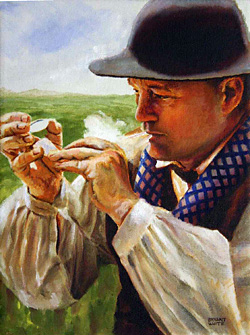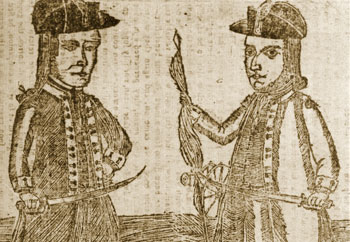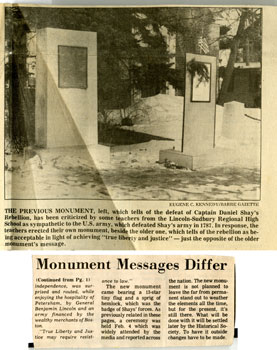Historic Scenes
Epilogue: Our Debt to Shays
Less than a year after the bloody encounter at the Springfield Arsenal, Captain Agrippa Wells faced a new adversary. This time, it was not artillery fire but the proposed federal Constitution created at Philadelphia the previous summer. Bernardston had elected Wells to represent the town at the Massachusetts ratifying convention in Boston. Wells’ instructions were clear: he was “not totally, to reject” the proposed Constitution as the town was “of the opinion with proper amendments, it may be adapted to secure our liberties, and answer the Design of the general Union.” When the final vote was called on February 6, 1788, “Captain Grip” lived up to a life-long reputation for independent thinking. He ignored the town’s instructions and voted against ratification. [1]

Agrippa Wells, © 2008 Bryant White
Agrippa Wells was hardly unique among the delegates in opposing the Constitution, or in his Regulator past. The Reverend Jeremy Belknap of Boston reported disapprovingly that the 355 convention delegates included “A mixture of all sorts of Characters! Some…Insurgents of last winter among them. Several of Shays’s Captains & Counsellors.” The basic mistrust and hostility toward distant, centralized government that characterized the Regulation led many communities to vote against ratification. The Constitution passed by a scant 19 votes. [2]
At the same time, fears of renewed turmoil and violence convinced delegates who opposed the Constitution to rally behind the majority decision to ratify. Abraham White of Norton was typical in his assurance that “yet as a majority had seen fit to adopt it, he should use his utmost exertions to induce his constituents to live in peace under, and cheerfully submit to it.” A relieved Benjamin Lincoln confided to George Washington that “Considering the disorders that took place in this State the last winter, and considering the great influence the spirit which then reigned has had since on all our operations it must be supposed that we have got through this pretty well.” [3]
The convention secretary, George Richards Minot, spent the remainder of 1788 completing a thorough account and explanation of the Regulation. Published that same year, Minot’s title clearly identified what he and the Friends of Government within and outside Massachusetts believed to be the true nature of the Regulation: The History of the Insurrections in Massachusetts…and the Rebellion Consequent Thereon. [4]

1787 woodcut showing Daniel Shays and Job Shattuck. More info Courtesy Courtesy National Portrait Gallery, Smithsonian Institution, Washington, DC
It was a short step from a history branding the Regulation a “rebellion,” to linking that rebellion permanently to the man believed to be its principal leader. Eighteenth-century assumptions regarding mass movements and their sources encouraged contemporaries to view the Regulation as a conspiracy led by one or a few ambitious, unprincipled men. Abigail Adams believed the entire affair was engineered by “Ignorant, restless desperados, without conscience or principles” who “led a deluded multitude to follow their standard.” George Washington suggested that Daniel Shays himself was “the dupe of some characters who are yet behind the curtain.” That Daniel Shays was a Regulator is beyond dispute; that he led a rebellion is questionable. Shays himself emphatically denied it: “I at their head! I am not!” The myth of Daniel Shays has endured in part because we know so little about him. [5]
With the bicentennial of the Regulation, Shays became something of a folk hero. In contrast to the “desperate debtor” Alexander Hamilton, condemned in the Federalist Papers, Shays emerged in the 1980s as the champion of the oppressed, leading a tax revolt against wealthy, privileged eastern interests. In this new interpretation of the Regulation, Shays’ champions replaced the old set of conspirators with another—the wealthy men from Boston who financed the government militia called out to defeat the Regulators.

1987 newspaper article from the Barre Gazette showing temporary monument to Shays. More info Courtesy Petersham Historical Society, Petersham, MA
Two monuments erected at Petersham neatly summarize the evolving legacy of Daniel Shays and the movement still commonly referred to as Shays’ Rebellion. The first monument was dedicated in 1927. It celebrates the “rout” of Shays and “his followers” at Petersham by Massachusetts militia in February, 1787 and the role this victory played in the creation of the United States Constitution. According to this monument, “Obedience to law is true liberty.” A second monument erected in 1987 offers a counter interpretation of Daniel Shays and the Regulation: Shays and his followers “fought for the common people against the established powers” and “tried to make real the vision of justice and equality embodied in our revolutionary declaration of independence.” According to one of its authors, this second monument “enshrines Shays as the hero, whose actions called back the first principles and highest ideals of the Revolution. We hope that now, 200 years after his defeat, Captain Shays can be said to have won this last battle in history.” [6]
Denounced by their opponents as desperate debtors and anarchists, the Regulators and their sympathizers share a lasting legacy in the creation of the Constitution itself; it is thus we who are ultimately indebted to them. In their actions and protests, the Regulators raised fundamental questions about the relationship between citizens and their government and the accountability of those who govern. “Shays’ Rebellion” is a powerful reminder that such questions have always been, and will remain, at the heart of the American experiment.
[1] Bernardston and Leyden, Hampshire County, 26 November, Town Meeting and Instructions, 26 November in John P. Kaminski, Gaspare J. Saladino, Richard Leffler, Charles H. Schoenleber and Margaret A. Hogan eds., The Documentary History of the Ratification of the Constitution, Ratification of the States: Massachusetts (Madison: State Historical Society of Wisconsin, 1986-2007), vol. 4, pg. 904. For votes of individual delegates at the Convention, see Ibid., p. 1155.
[2] Ibid., p. 1155.
[3] Benjamin Lincoln to George Washington, 9 February 1788 in Ibid., 1688.
[4] George Richards Minot, The History of the Insurrections in Massachusetts in the year Seventeen Hundred and Eighty-Six and the Rebellion Consequent Thereon (Worcester, 788).
[5] Gordon S. Wood, "Conspiracy and the Paranoid Style: Causality and Deceit in the Eighteenth Century,"William and Mary Quarterly 3d ser., 39 (1982): 401-406; Abigail Adams to Thomas Jefferson, 29 January 1787, in Lester J. Capon, ed., The Adams-Jefferson Letters: The Complete Correspondence between Thomas Jefferson and Abigail and John Adams (Chapel Hill: University of North Carolina Press, 1988) 168; George Washington to Henry Knox, February 25, 1787, in The Papers of George Washington, Confederation Series (Charlottesville: University Press of Virginia, 1992-97) 5:486; Daniel Shays to Rufus Putnam, quoted in Marion Starkey, A Little Rebellion (New York: Alfrad A. Knopf, 1955), 121.
[6] “Two monuments, Two Opinions Explain the Shay’s [sic] Army Defeat”, 19 February 1987, Barre Gazette.